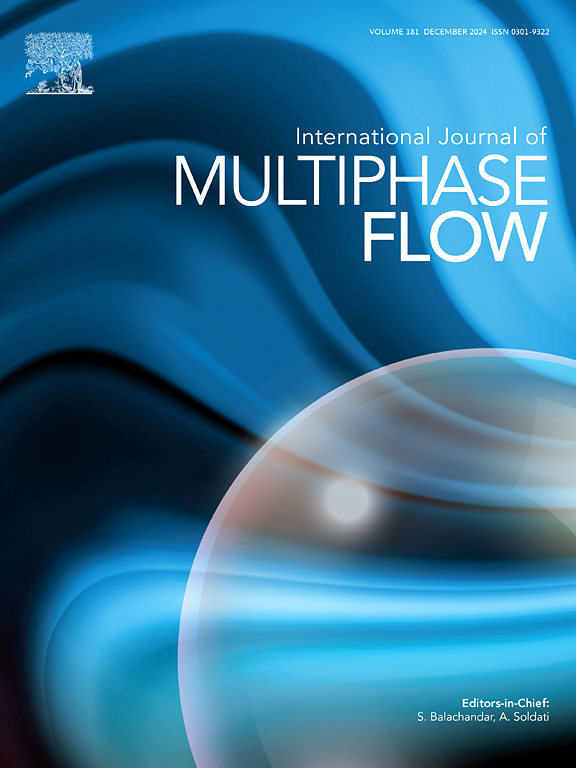确定水滴撞击倾斜超疏水纹理表面后预反弹滑动长度的基于最大扩展的方法
IF 3.8
2区 工程技术
Q1 MECHANICS
International Journal of Multiphase Flow
Pub Date : 2025-04-10
DOI:10.1016/j.ijmultiphaseflow.2025.105257
引用次数: 0
摘要
液滴沿自洁、防冰、防污和防水涂层滑动的数学预测对研究和工程开发具有重要的吸引力。该工作涉及一种半经验方法的发展,用于估计2.1 mm水滴沿倾斜(0-85°)超疏水微纹理表面(推进接触角为162-164°)反弹之前的滑动长度。该方法基于基于能量守恒的预测,将冲击水滴(0.5-3.2 m/s)的最大扩散直径作为其滑动前的时间矩。在粘性耗散功方程中,提出通过微织构表面润湿压力与反润湿压力的法向比来考虑液滴最大扩散时间。该方法揭示了液滴滑动长度与其最大扩散直径之间的线性关系。结果表明,模拟微织构内部元素的润湿是预测这两个过程特征的关键步骤。作为创建估计滑动长度的半经验方法的先决条件,合理地提出和讨论了这一特性的经验建模的困难。通过强调附着功在扩散物理中的重要性,证实了该方法预测最大扩散系数的有效性。研究结果表明,利用具有选定周期性、接触角和自由表面能的微织构粗糙表面作为实用的拒水涂层是有效的。这种表面结构已被证明在实际应用中有效地排斥水。本文章由计算机程序翻译,如有差异,请以英文原文为准。

Maximum spreading-based method for determining the pre-rebounding sliding length of a water droplet after impact on an inclined superhydrophobic textured surface
Mathematical prediction of liquid droplet sliding along self-cleaning, anti-icing, anti-fouling and water-repellent coatings is critically attractive for research and engineering development. The work deals with the development of a semi-empirical method for estimating the sliding length of a 2.1-mm water droplet before its rebound along inclined (0-85°) superhydrophobic micro-textured surfaces with advancing contact angles of 162-164°. The method is based on energy conservation-based prediction of the maximum spreading diameter of an impacting (0.5-3.2 m/s) water droplet as a time moment preceding its sliding. In the viscous dissipation work equation, the time of maximum droplet spreading is proposed to be considered through the normal ratio of wetting and antiwetting pressures of micro-textured surfaces. The developed method revealed a linear relationship between the sliding length of a droplet and its maximum spreading diameter. It was demonstrated that modeling the wetting of the internal elements of micro-textures is a crucial step in predicting the characteristics of both processes. As a prerequisite for the creation of a semi-empirical method for estimating the sliding length, the difficulties of empirical modeling of this characteristic are reasonably presented and discussed. The validity of the method for predicting the maximum spreading coefficient is substantiated by emphasizing the importance of adhesion work in the physics of spreading. The results of the study demonstrate the effectiveness of using the micro-textured, rough surface with a selected periodicity, contact angle and free surface energy as a practical water-repellent coating. This surface structure has been demonstrated to effectively repel water in real-world applications.
求助全文
通过发布文献求助,成功后即可免费获取论文全文。
去求助
来源期刊
CiteScore
7.30
自引率
10.50%
发文量
244
审稿时长
4 months
期刊介绍:
The International Journal of Multiphase Flow publishes analytical, numerical and experimental articles of lasting interest. The scope of the journal includes all aspects of mass, momentum and energy exchange phenomena among different phases such as occur in disperse flows, gas–liquid and liquid–liquid flows, flows in porous media, boiling, granular flows and others.
The journal publishes full papers, brief communications and conference announcements.

 求助内容:
求助内容: 应助结果提醒方式:
应助结果提醒方式:


